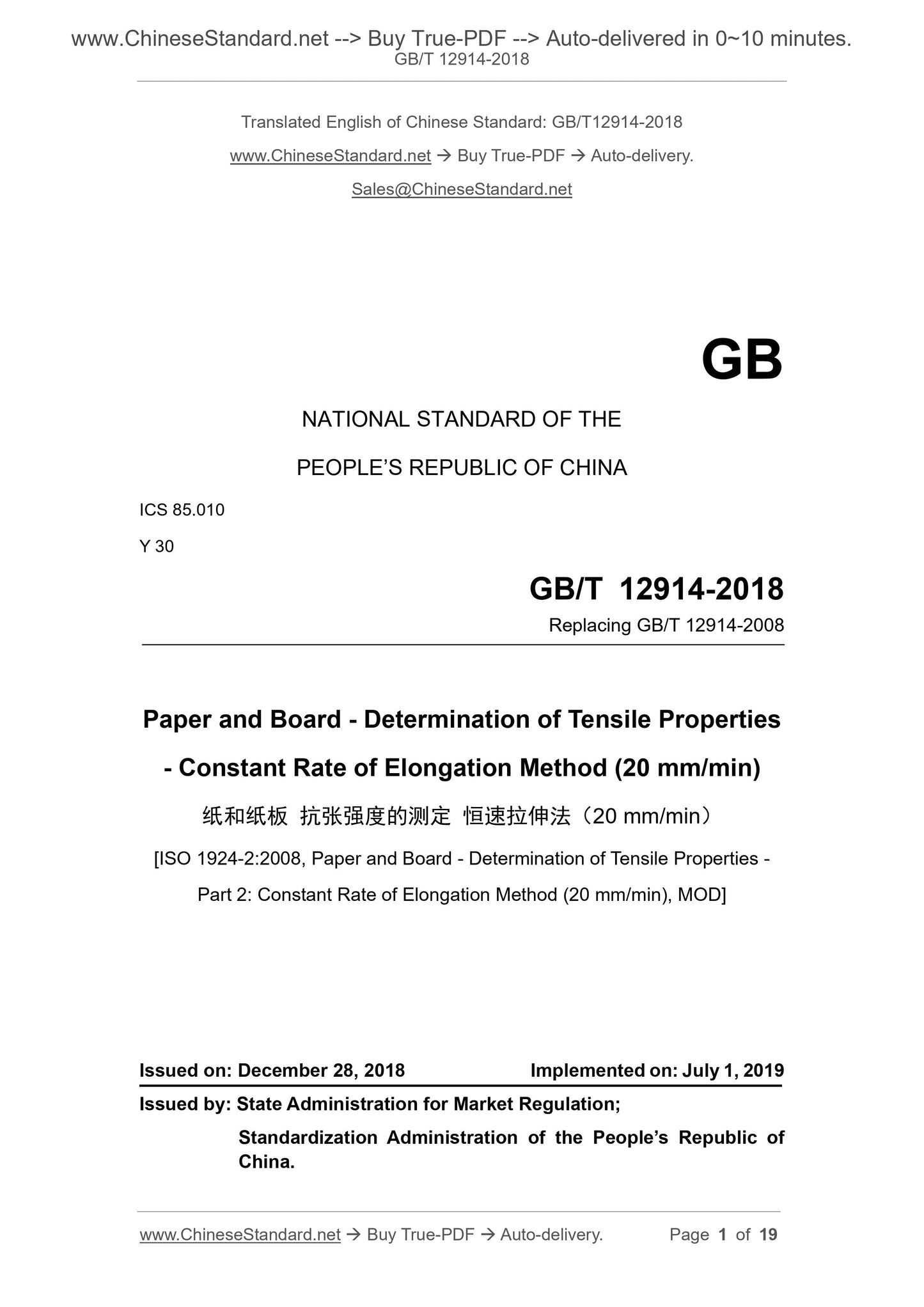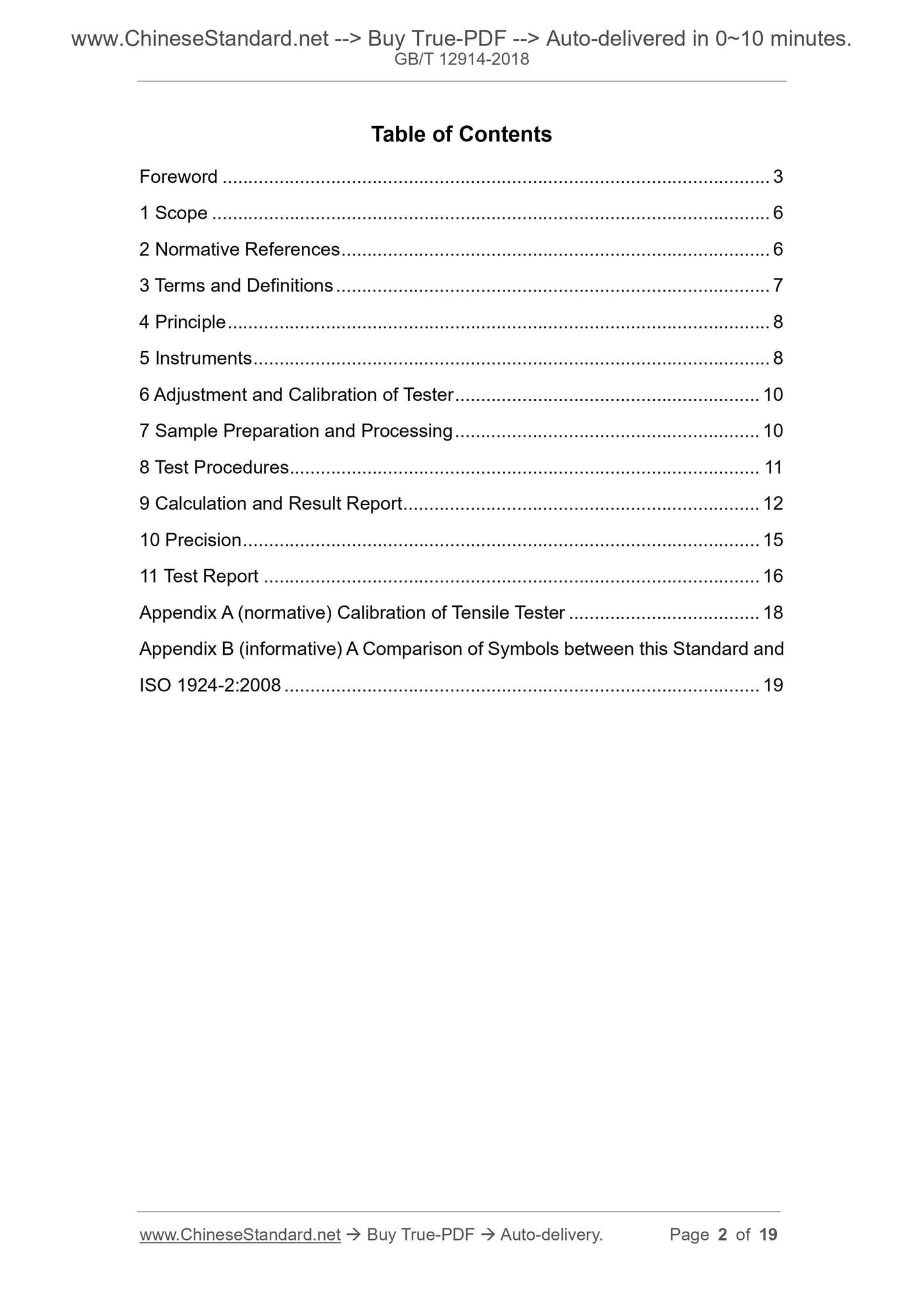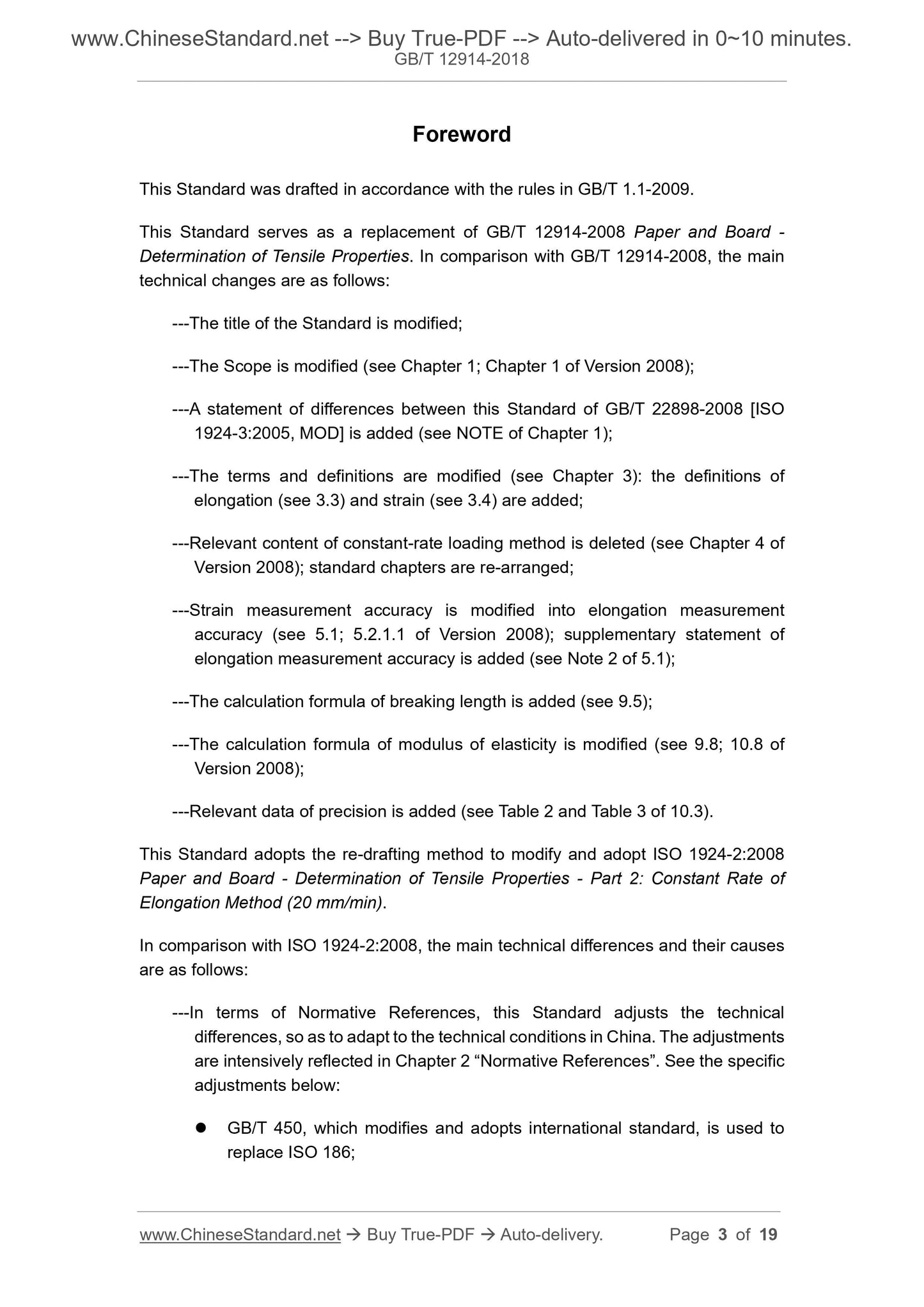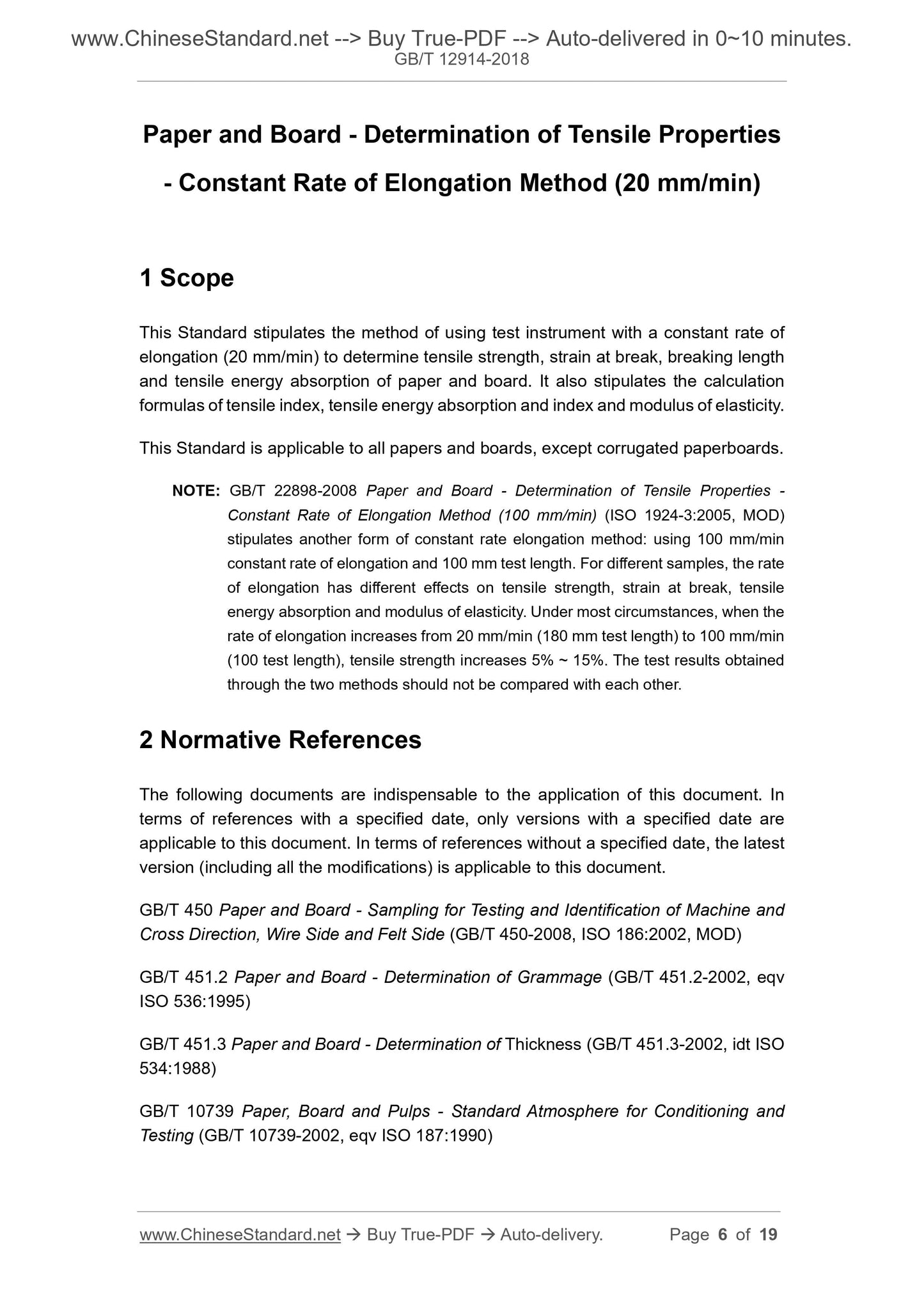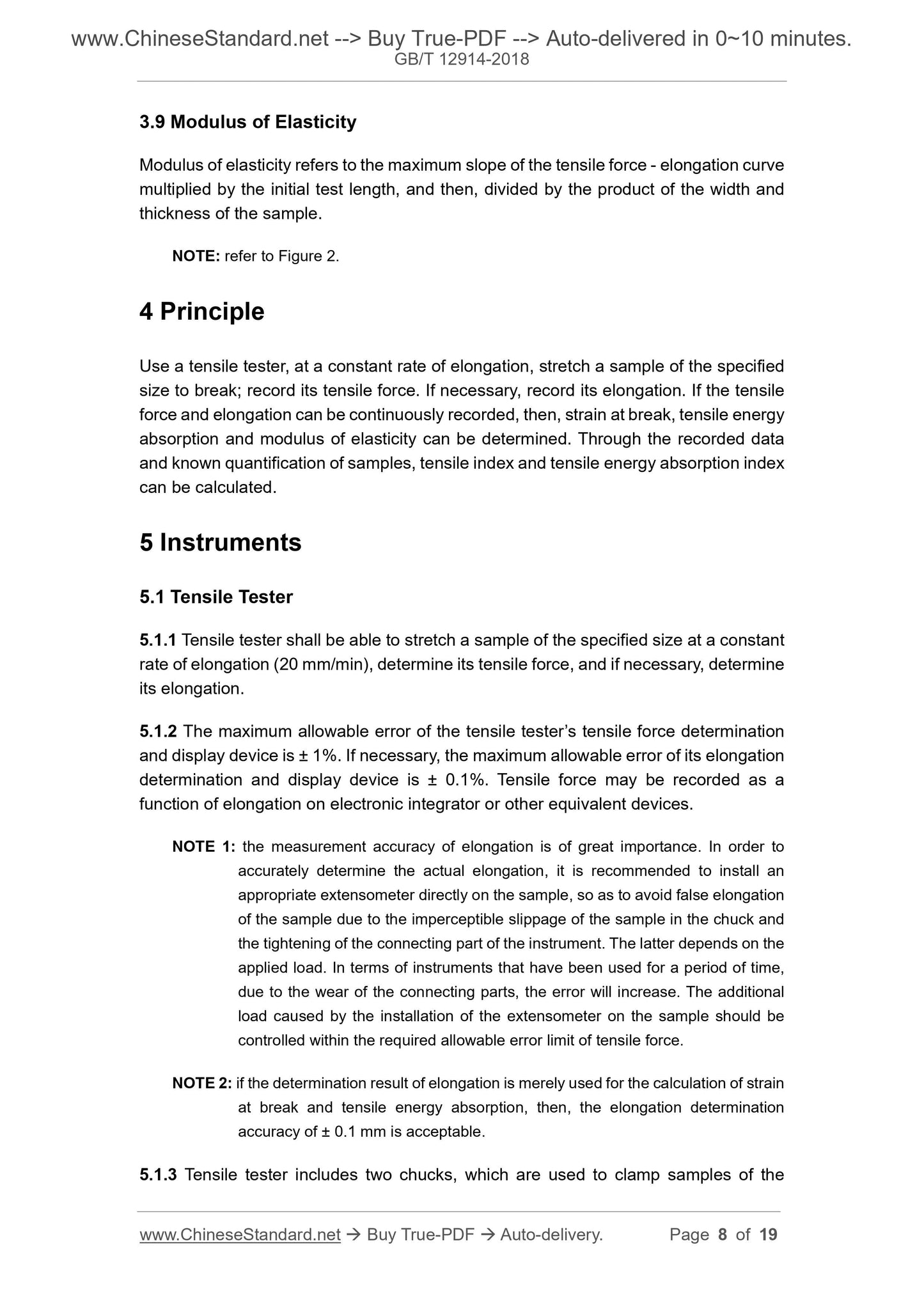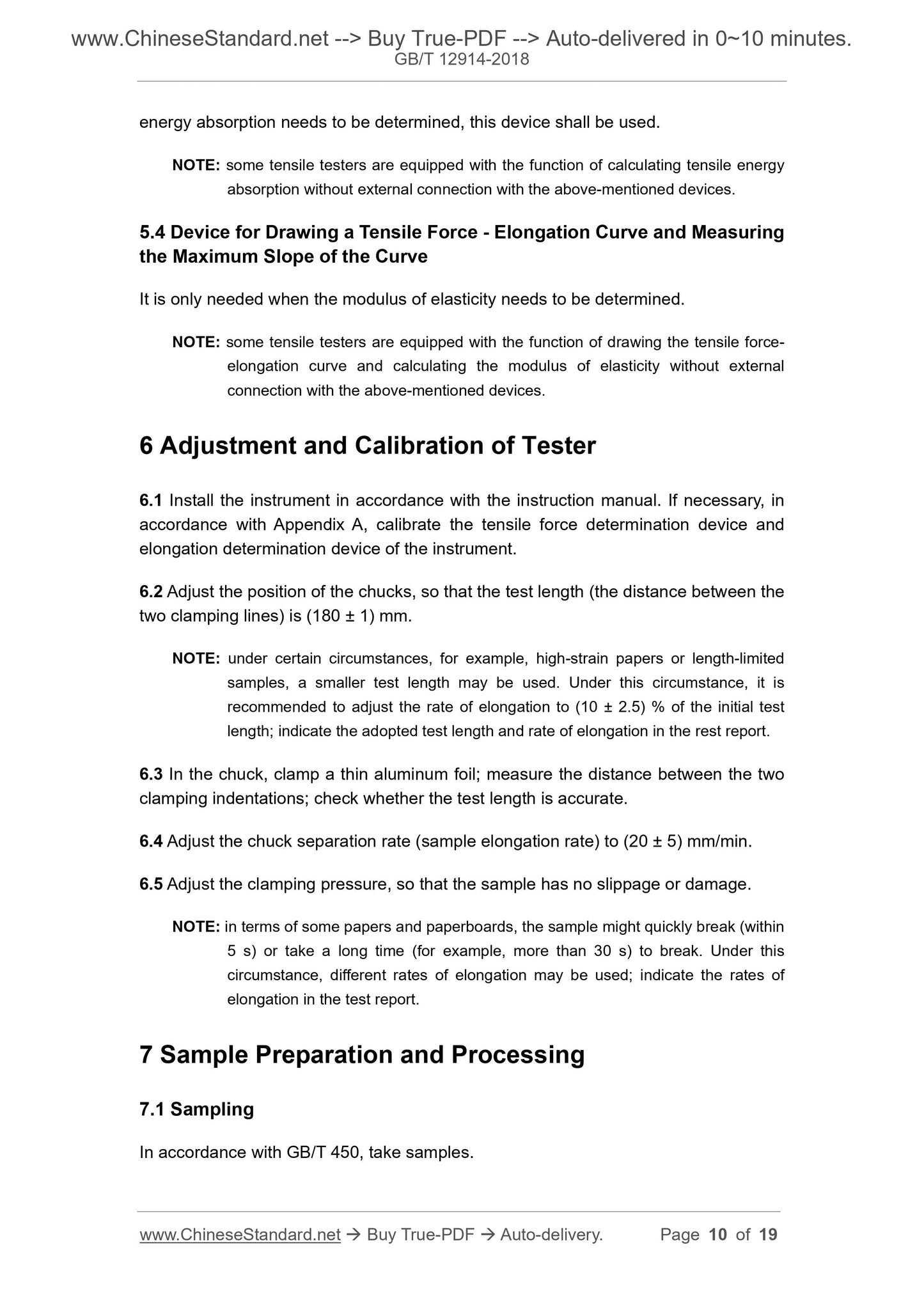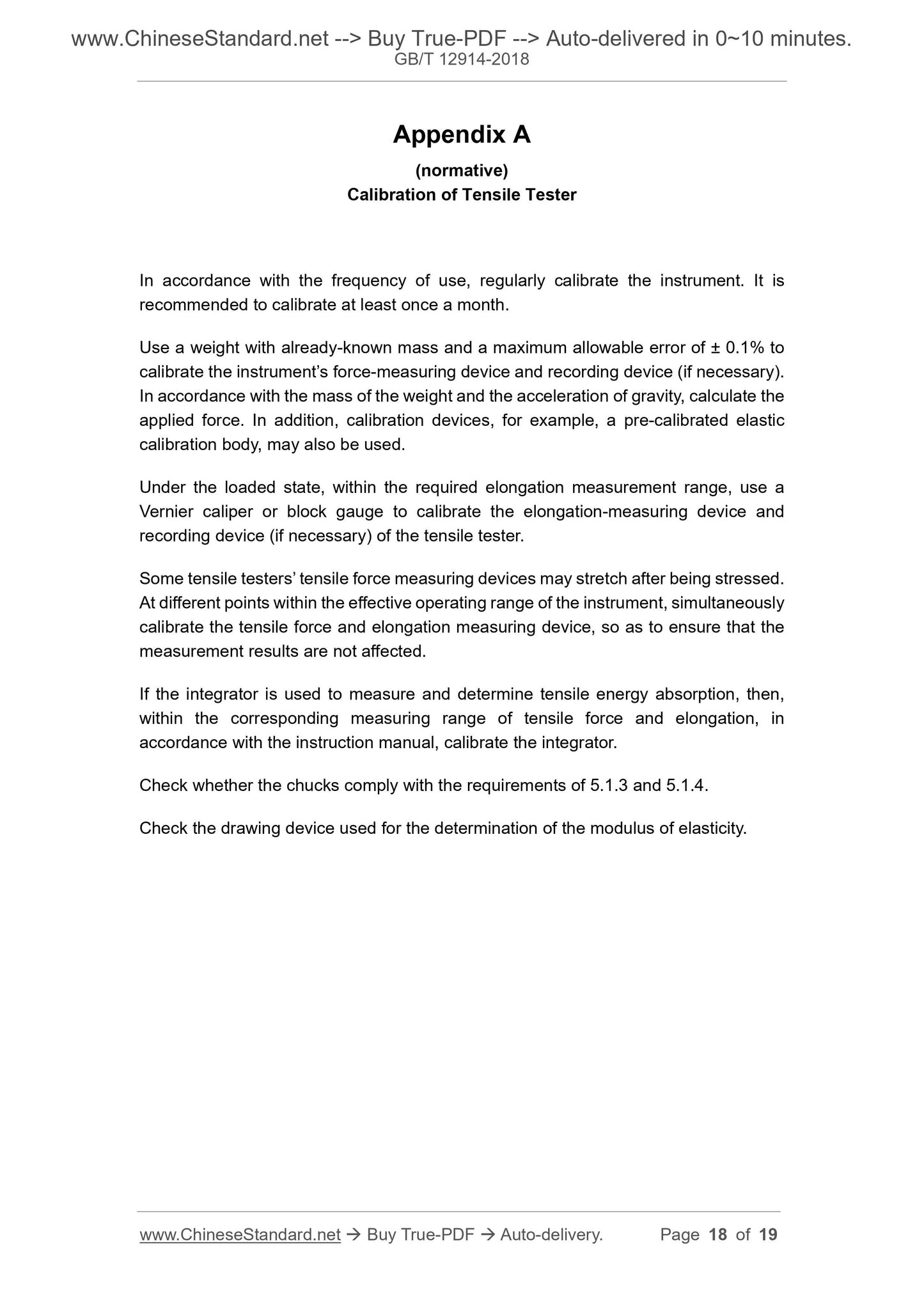1
/
su
8
PayPal, credit cards. Download editable-PDF and invoice in 1 second!
GB/T 12914-2018 English PDF (GBT12914-2018)
GB/T 12914-2018 English PDF (GBT12914-2018)
Prezzo di listino
$170.00 USD
Prezzo di listino
Prezzo scontato
$170.00 USD
Prezzo unitario
/
per
Spese di spedizione calcolate al check-out.
Impossibile caricare la disponibilità di ritiro
Delivery: 3 seconds. Download true-PDF + Invoice.
Get QUOTATION in 1-minute: Click GB/T 12914-2018
Historical versions: GB/T 12914-2018
Preview True-PDF (Reload/Scroll if blank)
GB/T 12914-2018: Paper and board -- Determination of tensile properties -- Constant rate of elongation method (20mm/min)
GB/T 12914-2018
NATIONAL STANDARD OF THE
PEOPLE’S REPUBLIC OF CHINA
ICS 85.010
Y 30
Replacing GB/T 12914-2008
Paper and Board - Determination of Tensile Properties
- Constant Rate of Elongation Method (20 mm/min)
[ISO 1924-2:2008, Paper and Board - Determination of Tensile Properties -
Part 2: Constant Rate of Elongation Method (20 mm/min), MOD]
ISSUED ON: DECEMBER 28, 2018
IMPLEMENTED ON: JULY 1, 2019
Issued by: State Administration for Market Regulation;
Standardization Administration of the People’s Republic of
China.
Table of Contents
Foreword ... 3
1 Scope ... 6
2 Normative References ... 6
3 Terms and Definitions ... 7
4 Principle ... 8
5 Instruments ... 8
6 Adjustment and Calibration of Tester ... 10
7 Sample Preparation and Processing ... 10
8 Test Procedures ... 11
9 Calculation and Result Report ... 12
10 Precision ... 15
11 Test Report ... 16
Appendix A (normative) Calibration of Tensile Tester ... 18
Appendix B (informative) A Comparison of Symbols between this Standard and
ISO 1924-2:2008 ... 19
Foreword
This Standard was drafted in accordance with the rules in GB/T 1.1-2009.
This Standard serves as a replacement of GB/T 12914-2008 Paper and Board -
Determination of Tensile Properties. In comparison with GB/T 12914-2008, the main
technical changes are as follows:
---The title of the Standard is modified;
---The Scope is modified (see Chapter 1; Chapter 1 of Version 2008);
---A statement of differences between this Standard of GB/T 22898-2008 [ISO
1924-3:2005, MOD] is added (see NOTE of Chapter 1);
---The terms and definitions are modified (see Chapter 3): the definitions of
elongation (see 3.3) and strain (see 3.4) are added;
---Relevant content of constant-rate loading method is deleted (see Chapter 4 of
Version 2008); standard chapters are re-arranged;
---Strain measurement accuracy is modified into elongation measurement
accuracy (see 5.1; 5.2.1.1 of Version 2008); supplementary statement of
elongation measurement accuracy is added (see Note 2 of 5.1);
---The calculation formula of breaking length is added (see 9.5);
---The calculation formula of modulus of elasticity is modified (see 9.8; 10.8 of
Version 2008);
---Relevant data of precision is added (see Table 2 and Table 3 of 10.3).
This Standard adopts the re-drafting method to modify and adopt ISO 1924-2:2008
Paper and Board - Determination of Tensile Properties - Part 2: Constant Rate of
Elongation Method (20 mm/min).
In comparison with ISO 1924-2:2008, the main technical differences and their causes
are as follows:
---In terms of Normative References, this Standard adjusts the technical
differences, so as to adapt to the technical conditions in China. The adjustments
are intensively reflected in Chapter 2 “Normative References”. See the specific
adjustments below:
GB/T 450, which modifies and adopts international standard, is used to
replace ISO 186;
Paper and Board - Determination of Tensile Properties
- Constant Rate of Elongation Method (20 mm/min)
1 Scope
This Standard stipulates the method of using test instrument with a constant rate of
elongation (20 mm/min) to determine tensile strength, strain at break, breaking length
and tensile energy absorption of paper and board. It also stipulates the calculation
formulas of tensile index, tensile energy absorption and index and modulus of elasticity.
This Standard is applicable to all papers and boards, except corrugated paperboards.
NOTE: GB/T 22898-2008 Paper and Board - Determination of Tensile Properties -
Constant Rate of Elongation Method (100 mm/min) (ISO 1924-3:2005, MOD)
stipulates another form of constant rate elongation method: using 100 mm/min
constant rate of elongation and 100 mm test length. For different samples, the rate
of elongation has different effects on tensile strength, strain at break, tensile
energy absorption and modulus of elasticity. Under most circumstances, when the
rate of elongation increases from 20 mm/min (180 mm test length) to 100 mm/min
(100 test length), tensile strength increases 5% ~ 15%. The test results obtained
through the two methods should not be compared with each other.
2 Normative References
The following documents are indispensable to the application of this document. In
terms of references with a specified date, only versions with a specified date are
applicable to this document. In terms of references without a specified date, the latest
version (including all the modifications) is applicable to this document.
GB/T 450 Paper and Board - Sampling for Testing and Identification of Machine and
Cross Direction, Wire Side and Felt Side (GB/T 450-2008, ISO 186:2002, MOD)
GB/T 451.2 Paper and Board - Determination of Grammage (GB/T 451.2-2002, eqv
ISO 536:1995)
GB/T 451.3 Paper and Board - Determination of Thickness (GB/T 451.3-2002, idt ISO
534:1988)
GB/T 10739 Paper, Board and Pulps - Standard Atmosphere for Conditioning and
Testing (GB/T 10739-2002, eqv ISO 187:1990)
3.9 Modulus of Elasticity
Modulus of elasticity refers to the maximum slope of the tensile force - elongation curve
multiplied by the initial test length, and then, divided by the product of the width and
thickness of the sample.
NOTE: refer to Figure 2.
4 Principle
Use a tensile tester, at a constant rate of elongation, stretch a sample of the specified
size to break; record its tensile force. If necessary, record its elongation. If the tensile
force and elongation can be continuously recorded, then, strain at break, tensile energy
absorption and modulus of elasticity can be determined. Through the recorded data
and known quantification of samples, tensile index and tensile energy absorption index
can be calculated.
5 Instruments
5.1 Tensile Tester
5.1.1 Tensile tester shall be able to stretch a sample of the specified size at a constant
rate of elongation (20 mm/min), determine its tensile force, and if necessary, determine
its elongation.
5.1.2 The maximum allowable error of the tensile tester’s tensile force determination
and display device is ± 1%. If necessary, the maximum allowable error of its elongation
determination and display device is ± 0.1%. Tensile force may be recorded as a
function of elongation on electronic integrator or other equivalent devices.
NOTE 1: the measurement accuracy of elongation is of great importance. In order to
accurately determine the actual elongation, it is recommended to install an
appropriate extensometer directly on the sample, so as to avoid false elongation
of the sample due to the imperceptible slippage of the sample in the chuck and
the tightening of the connecting part of the instrument. The latter depends on the
applied load. In terms of instruments that have been used for a period of time,
due to the wear of the connecting parts, the error will increase. The additional
load caused by the installation of the extensometer on the sample should be
controlled within the required allowable error limit of tensile force.
NOTE 2: if the determination result of elongation is merely used for the calculation of strain
at break and tensile energy absorption, then, the elongation determination
accuracy of ± 0.1 mm is acceptable.
5.1.3 Tensile tester includes two chucks, which are used to clamp samples of the
energy absorption needs to be determined, this device shall be used.
NOTE: some tensile testers are equipped with the function of calculati...
Get QUOTATION in 1-minute: Click GB/T 12914-2018
Historical versions: GB/T 12914-2018
Preview True-PDF (Reload/Scroll if blank)
GB/T 12914-2018: Paper and board -- Determination of tensile properties -- Constant rate of elongation method (20mm/min)
GB/T 12914-2018
NATIONAL STANDARD OF THE
PEOPLE’S REPUBLIC OF CHINA
ICS 85.010
Y 30
Replacing GB/T 12914-2008
Paper and Board - Determination of Tensile Properties
- Constant Rate of Elongation Method (20 mm/min)
[ISO 1924-2:2008, Paper and Board - Determination of Tensile Properties -
Part 2: Constant Rate of Elongation Method (20 mm/min), MOD]
ISSUED ON: DECEMBER 28, 2018
IMPLEMENTED ON: JULY 1, 2019
Issued by: State Administration for Market Regulation;
Standardization Administration of the People’s Republic of
China.
Table of Contents
Foreword ... 3
1 Scope ... 6
2 Normative References ... 6
3 Terms and Definitions ... 7
4 Principle ... 8
5 Instruments ... 8
6 Adjustment and Calibration of Tester ... 10
7 Sample Preparation and Processing ... 10
8 Test Procedures ... 11
9 Calculation and Result Report ... 12
10 Precision ... 15
11 Test Report ... 16
Appendix A (normative) Calibration of Tensile Tester ... 18
Appendix B (informative) A Comparison of Symbols between this Standard and
ISO 1924-2:2008 ... 19
Foreword
This Standard was drafted in accordance with the rules in GB/T 1.1-2009.
This Standard serves as a replacement of GB/T 12914-2008 Paper and Board -
Determination of Tensile Properties. In comparison with GB/T 12914-2008, the main
technical changes are as follows:
---The title of the Standard is modified;
---The Scope is modified (see Chapter 1; Chapter 1 of Version 2008);
---A statement of differences between this Standard of GB/T 22898-2008 [ISO
1924-3:2005, MOD] is added (see NOTE of Chapter 1);
---The terms and definitions are modified (see Chapter 3): the definitions of
elongation (see 3.3) and strain (see 3.4) are added;
---Relevant content of constant-rate loading method is deleted (see Chapter 4 of
Version 2008); standard chapters are re-arranged;
---Strain measurement accuracy is modified into elongation measurement
accuracy (see 5.1; 5.2.1.1 of Version 2008); supplementary statement of
elongation measurement accuracy is added (see Note 2 of 5.1);
---The calculation formula of breaking length is added (see 9.5);
---The calculation formula of modulus of elasticity is modified (see 9.8; 10.8 of
Version 2008);
---Relevant data of precision is added (see Table 2 and Table 3 of 10.3).
This Standard adopts the re-drafting method to modify and adopt ISO 1924-2:2008
Paper and Board - Determination of Tensile Properties - Part 2: Constant Rate of
Elongation Method (20 mm/min).
In comparison with ISO 1924-2:2008, the main technical differences and their causes
are as follows:
---In terms of Normative References, this Standard adjusts the technical
differences, so as to adapt to the technical conditions in China. The adjustments
are intensively reflected in Chapter 2 “Normative References”. See the specific
adjustments below:
GB/T 450, which modifies and adopts international standard, is used to
replace ISO 186;
Paper and Board - Determination of Tensile Properties
- Constant Rate of Elongation Method (20 mm/min)
1 Scope
This Standard stipulates the method of using test instrument with a constant rate of
elongation (20 mm/min) to determine tensile strength, strain at break, breaking length
and tensile energy absorption of paper and board. It also stipulates the calculation
formulas of tensile index, tensile energy absorption and index and modulus of elasticity.
This Standard is applicable to all papers and boards, except corrugated paperboards.
NOTE: GB/T 22898-2008 Paper and Board - Determination of Tensile Properties -
Constant Rate of Elongation Method (100 mm/min) (ISO 1924-3:2005, MOD)
stipulates another form of constant rate elongation method: using 100 mm/min
constant rate of elongation and 100 mm test length. For different samples, the rate
of elongation has different effects on tensile strength, strain at break, tensile
energy absorption and modulus of elasticity. Under most circumstances, when the
rate of elongation increases from 20 mm/min (180 mm test length) to 100 mm/min
(100 test length), tensile strength increases 5% ~ 15%. The test results obtained
through the two methods should not be compared with each other.
2 Normative References
The following documents are indispensable to the application of this document. In
terms of references with a specified date, only versions with a specified date are
applicable to this document. In terms of references without a specified date, the latest
version (including all the modifications) is applicable to this document.
GB/T 450 Paper and Board - Sampling for Testing and Identification of Machine and
Cross Direction, Wire Side and Felt Side (GB/T 450-2008, ISO 186:2002, MOD)
GB/T 451.2 Paper and Board - Determination of Grammage (GB/T 451.2-2002, eqv
ISO 536:1995)
GB/T 451.3 Paper and Board - Determination of Thickness (GB/T 451.3-2002, idt ISO
534:1988)
GB/T 10739 Paper, Board and Pulps - Standard Atmosphere for Conditioning and
Testing (GB/T 10739-2002, eqv ISO 187:1990)
3.9 Modulus of Elasticity
Modulus of elasticity refers to the maximum slope of the tensile force - elongation curve
multiplied by the initial test length, and then, divided by the product of the width and
thickness of the sample.
NOTE: refer to Figure 2.
4 Principle
Use a tensile tester, at a constant rate of elongation, stretch a sample of the specified
size to break; record its tensile force. If necessary, record its elongation. If the tensile
force and elongation can be continuously recorded, then, strain at break, tensile energy
absorption and modulus of elasticity can be determined. Through the recorded data
and known quantification of samples, tensile index and tensile energy absorption index
can be calculated.
5 Instruments
5.1 Tensile Tester
5.1.1 Tensile tester shall be able to stretch a sample of the specified size at a constant
rate of elongation (20 mm/min), determine its tensile force, and if necessary, determine
its elongation.
5.1.2 The maximum allowable error of the tensile tester’s tensile force determination
and display device is ± 1%. If necessary, the maximum allowable error of its elongation
determination and display device is ± 0.1%. Tensile force may be recorded as a
function of elongation on electronic integrator or other equivalent devices.
NOTE 1: the measurement accuracy of elongation is of great importance. In order to
accurately determine the actual elongation, it is recommended to install an
appropriate extensometer directly on the sample, so as to avoid false elongation
of the sample due to the imperceptible slippage of the sample in the chuck and
the tightening of the connecting part of the instrument. The latter depends on the
applied load. In terms of instruments that have been used for a period of time,
due to the wear of the connecting parts, the error will increase. The additional
load caused by the installation of the extensometer on the sample should be
controlled within the required allowable error limit of tensile force.
NOTE 2: if the determination result of elongation is merely used for the calculation of strain
at break and tensile energy absorption, then, the elongation determination
accuracy of ± 0.1 mm is acceptable.
5.1.3 Tensile tester includes two chucks, which are used to clamp samples of the
energy absorption needs to be determined, this device shall be used.
NOTE: some tensile testers are equipped with the function of calculati...
Share
